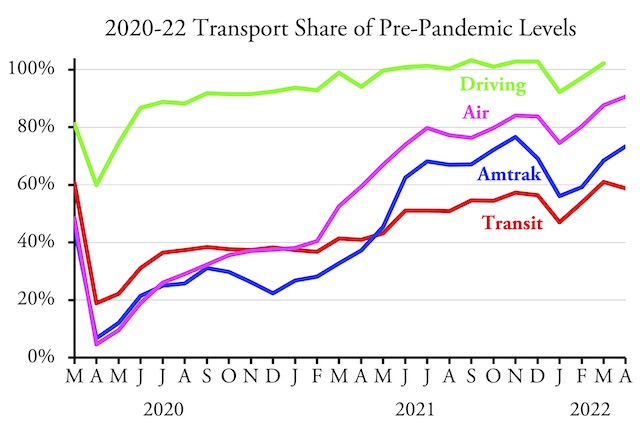Transit ridership in April 2022 was 58.7 percent of April 2019, according to data released yesterday by the Federal Transit Administration. This is down from March, when ridership was 61.0 percent of March 2019. When I reported on March numbers, I predicted that April’s numbers would fall below 60 percent of pre-pandemic levels because April 2022 had one fewer business day than April 2019, while March had two more than in 2019.
While airline and Amtrak numbers grew in April (as a percent of 2019 levels), transit numbers fell.
For comparison, airline numbers exceeded 90 percent of pre-pandemic levels (which I also predicted) while Amtrak ridership grew to 73 percent (though that’s a drop from November, when ridership was more than 77 percent of November 2019). Driving numbers won’t be out for another week or so, but will probably be around 100 percent.
It’s beginning to look like transit ridership may level off at not much more than 60 percent of pre-pandemic numbers. A data analyst named Todd Schneider has posted daily and weekly New York City subway turnstile numbers through early June, and they indicate that ridership has not grown much since March. His numbers also show that ridership in Manhattan has recovered less than in the other boroughs, showing that people are not returning to downtown jobs. New York’s subway carries almost 30 percent of all transit riders in the nation and it is actually doing a little better (April ridership was 64 percent of April 2019) than most other systems, so its lack of growth must have transit officials worried.
Of course, these numbers must be tempered by the fact that fare evasion has grown considerably since the pandemic, which means actual ridership is higher than turnstile numbers, but if fares were enforced some people would take fewer subway trips. Some people say that the solution to that is to let everyone ride free. But if your service is so bad that you can’t get people to pay even a quarter of the cost of providing that service, there can’t be much justification for increasing the subsidies still further.
Most transit agencies depend on fare revenues for at least part of their operating funds. As COVID relief funds run out, they are going to start demanding more subsidies to keep operating despite low ridership. Yesterday, San Francisco residents voted on a $400 million transportation bond that was supposed to “finance the capital projects needed to modernize and enhance Muni,” capital projects that are probably not necessary considering that Muni is carrying only 56 percent of pre-pandemic riders. Today’s news should reveal whether this was approved.
Update The San Francisco measure, which required approval of two-thirds of voters, appears to have lost as only 63 percent of voters were gullible enough to support it. Of course, that means it would have passed in almost any state but California.
As usual, I have posted an enhanced version of the Federal Transit Administration’s latest ridership data, which has 2002-2022 monthly ridership by transit agency and mode in cells A1 through IS2260. I have added annual totals in columns IT through JN; mode totals in rows 2264 through 2285; agency totals in rows 2290 through 3289; and urban area totals in rows 3295 through 3783. These enhancements are on both the UPT (ridership) and VRT (vehicle-revenue miles) worksheets.









For comparison, airline numbers exceeded 90 percent of pre-pandemic levels”
Airlines can easily liquidate a loss by flying fewer planes…….trains run empty if you use em or not….
There’s a multitude of tech that may revive the air market
1: The return of the turboprop! the jet age saw phase out of propeller planes in service, while props are still used they’re mostly for small planes. While Boeing and Airbus cartel shifted to jets the Turboprop and smaller planes but aerospace firms are revamping designs for 60-99 passenger turboprops for transportation.
2: Revival of the seaplanes, with composite materials offering water resistance and anti-rust/corrosion properties.
Open up travel to island archipelago nations without eating up land for major airports
Man, that’s a big drop in ridership. With gas prices at record highs, you’d expect that to push transit ridership up.
”
Airlines can easily liquidate a loss by flying fewer planes
” ~lazyreader
There’s nothing easy about not flying an asset that just cost you $100M – $250M to buy. That’s a recipe for bankruptcy. ~50 airlines went belly up in 2020 alone. In the US, Washington threw something like $50B or $100B at US airlines to keep them running.
Just curious, what is the advantage of turboprops? I guess they use less fuel? The reason I’ve heard about their replacement is that they couldn’t reach the cruising speed of jets (600 mph?).
The first plane I ever flew on was an Eastern Airlines Lockheed Electra turboprop. That was in 1977. From what I can find out about it the cruising speed was 350 mph and the seating capacity was 85-90. Is that correct?